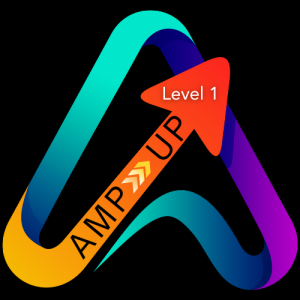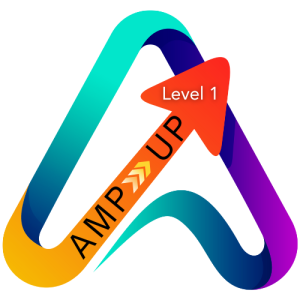-
$800.00 / Seat
-
$88.88 / month for 9 months / Seat
- Course Plan
- Course Content
- AmpUp Method
34-Week Learning Plan
13 Themed Units
Short, Engaging Video Lessons
Interactive Practice
Reinforce with Bonus Activities
Progress You Can See
In this unit, you’ll learn how your brain processes sounds and letters as you build a strong foundation for reading and spelling. We’ll explore the difference between voiced and unvoiced sounds, how the reading brain develops, and how to manipulate and mark sounds in words using proven strategies. You’ll also begin reading and spelling simple words with greater accuracy, using tools like sound mapping, tapping, and visual marking to understand how words are built.
This unit takes a closer look at how letters work together to form smooth, readable words. You’ll learn to decode and spell consonant blends and joined sounds like -ng, -nk, and -all, while applying key spelling rules for c, k, and ck. We’ll explore the difference between closed syllables and closed syllable exceptions, helping you spot when words follow predictable patterns—and when they don’t. You’ll also begin to understand how reductions in speech (like gonna or wanna) can affect reading clarity, and how the reading brain and spelling brain sometimes process information differently. This unit builds the awareness needed to become both a more fluent reader and a more accurate speller.
This unit introduces you to suffixes—word endings like -ed, -ing, -less, and -ment—and shows how they change the meaning and function of base words. You’ll practice combining base words with suffixes to build longer, more expressive words. A key focus will be on understanding how voiced and unvoiced final sounds in a word help you determine the correct pronunciation of -ed (as in jumped, played, or started). You’ll gain tools to recognize patterns in both reading and spelling, strengthening your ability to decode and construct words with confidence.
In this unit, you’ll learn how to break down longer words using syllable strategies that make complex words easier to tackle. You’ll explore common prefixes like un-, re-, and non-, as well as advanced suffixes like -ship, -hood, and -able, learning how they attach to base words and change meaning. You’ll also be introduced to more challenging word endings like -ic and -ct, which often appear in academic and descriptive vocabulary. This unit gives you the step-by-step tools to read, spell, and understand multisyllabic words with greater confidence and accuracy.
This unit explores the powerful Vowel-Consonant-e (VCe) pattern, which makes vowels say their names in words like cake, bike, and hope. You’ll apply spelling rules for soft c and g before e, i, and y, and learn how to add suffixes to VCe words without disrupting their vowel sounds. We’ll also investigate exceptions to the VCe rule, including the schwa o found in words like love, done, and some. To support vocabulary growth, you’ll continue expanding your prefix knowledge with advanced additions like re-, mis-, over-, and trans-.
In this unit, you’ll explore how open syllables—those that end in a vowel—help that vowel stay long, as in words like he, go, and my. You’ll also take a deeper look at the letter Y, which can represent different vowel sounds depending on where it appears in a word. We’ll study how Y functions as long I in short words and as long E in longer words, and how its behavior changes when suffixes like -ly, -y, and -ty are added. This unit helps you break down multisyllabic words more accurately and strengthens your ability to read and spell with greater confidence.
In this unit, you’ll tackle some of the most unpredictable sounds in English: r-controlled vowels like ar, or, and er. You’ll examine common spelling patterns, explore how these sounds change when suffixes are added, and practice breaking down multisyllabic words that contain r-controlled elements. We’ll also look at exceptions (such as ear in learn or bear) and discuss how regional dialects can affect how these sounds are heard and spelled. When rules break down, you’ll learn how to harness your reading brain to build spelling memory through patterns, visualization, and repetition—especially when logic alone won’t get you there.
In this unit, you’ll explore the many ways to spell the long A sound, including common patterns like a-e, ai, and ay, as well as less familiar ones like eigh, aigh, ei, and ey. You’ll learn how to recognize these patterns in both simple and multisyllabic words, apply suffixes without disrupting the vowel sound, and watch for subtle shifts in pronunciation. As you build spelling awareness, you’ll also examine homophones—words that sound the same but are spelled differently—and develop strategies for remembering which spelling belongs in which word. This unit strengthens your ability to decode, spell, and confidently navigate the complexity of long A patterns across all word types.
This unit focuses on the variety of spellings that create the long E sound, such as ee, ea, ey, e-e, and even y in words like happy. You’ll also uncover less common patterns like ie, ei, eo, and oe, which appear more frequently in advanced vocabulary. You’ll learn to apply suffixes while maintaining the vowel sound and analyze multisyllabic words that include these long E patterns. Special attention is given to homophones like sea/see or meat/meet, where accurate spelling depends on meaning, not just sound. This unit helps you strengthen both your decoding fluency and your spelling precision in more complex word structures.
In this unit, you’ll explore the multiple ways to spell the long O sound, including o-e, oa, oe, ow, and more complex patterns like ough, ew, and eau. You’ll also see how suffixes affect long O words and how to identify and spell long O homophones like know/no or rode/road. This unit helps you master long O spellings within both simple and multisyllabic words, preparing you for high-level vocabulary where visual memory and logical strategies work together to support accurate spelling and confident reading.
This unit dives into two dynamic diphthongs: /oi/ (as in boil, toy) and /ow/ (as in now, ouch). You’ll learn common spellings like oi/oy and ow/ou, apply suffixes, and break apart multisyllabic words that include these shifting vowel sounds. We’ll also explore homophones and rare spellings—especially how diphthongs show up in unpredictable patterns like ough. You’ll develop tools to handle words that don’t follow easy rules and gain a better understanding of how speech sounds blend and shift within different word structures.
In this unit, you’ll explore the many ways to spell the /oo/ sound, found in words like moon, blue, chew, and rude. You’ll compare spellings like oo, ue, ew, u-e, and ou, and also examine less common patterns like oe, ui, ough, and oeu. You’ll learn how these sounds behave in multisyllabic words, how suffixes can alter them, and how to distinguish similar-sounding words that are spelled differently. By the end of this unit, you’ll be able to confidently approach /oo/ words—whether they follow the rules or require visual memory and decoding strategies.
This final unit focuses on the deep /aw/ sound, found in words like saw, cause, and water. You’ll study common patterns like au and aw, then explore more advanced spellings like augh, al, and a (as in water), along with ough variants. You’ll learn how to apply suffixes to these words, tackle multisyllabic spellings, and work through homophones where meaning—not sound—determines correct spelling. This unit reinforces everything you’ve learned by giving you strategies to decode and spell even the most irregular /aw/ words with confidence and control.
- Overview
- Tab Title 2
- Tab Title 3
Enhance user experience with Advanced Tabs, allowing seamless content navigation. Organize information efficiently while keeping the interface clean and interactive. Perfect for FAQs, product details, or multi-section content.
The AmpUp Compass for Reading Success
The AmpUp Literacy courses use a unique approach that blends the best of several proven methods into one complete program. Think of it like a compass—each direction points to a proven, evidence-based method grounded in the science of reading, and together they guide your child toward confidence and mastery.
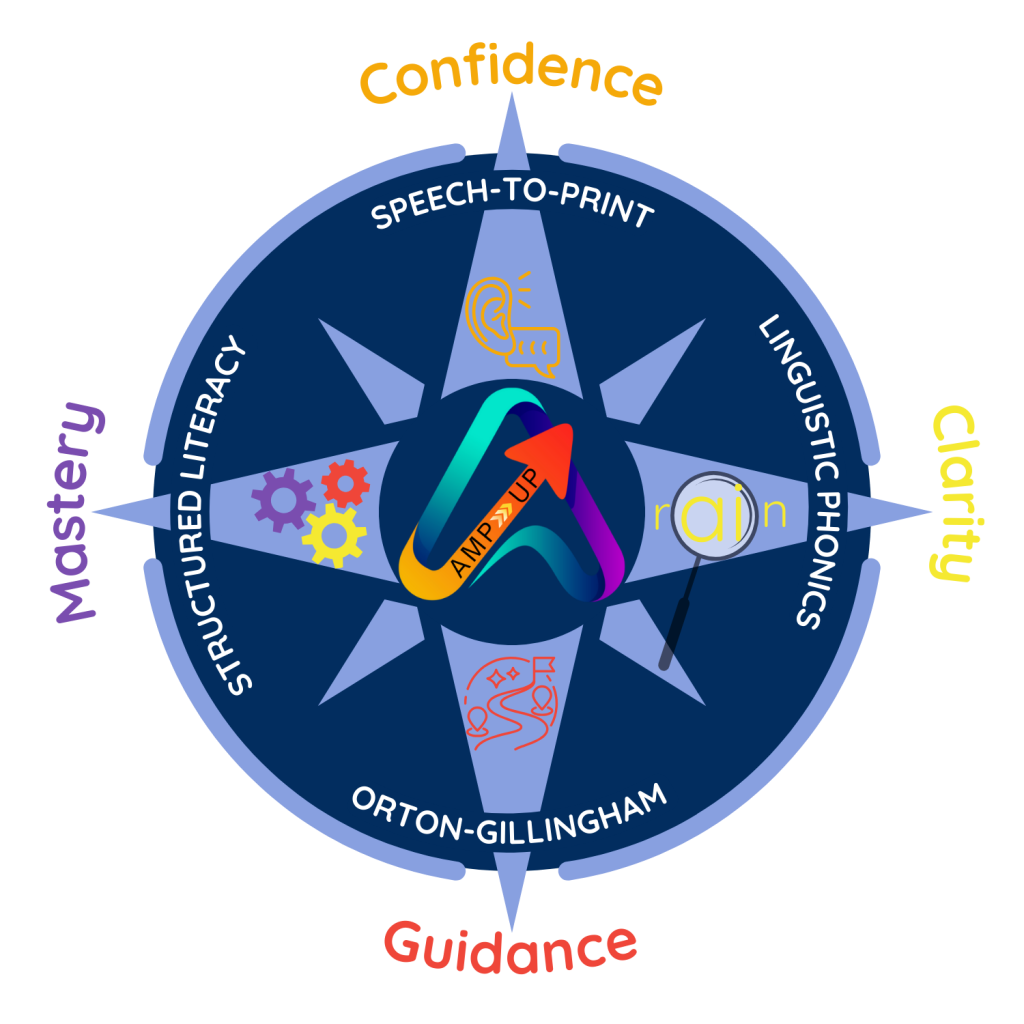
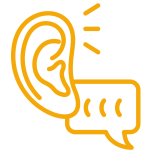
Speech-to-Print → Building Confidence
We start with speech sounds first. By connecting what students hear to the letters they see, they finally make sense of how English works. This sound-first approach builds confidence and takes away the guessing game in reading and spelling.
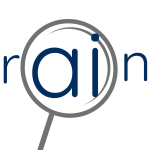
Linguistic Phonics → Gaining Clarity
English isn’t random—it’s a code! Through Linguistic Phonics, students learn to organize spellings by sound, uncover patterns, and understand why words are spelled the way they are. This gives them clarity instead of confusion.

Orton-Gillingham → Receiving Guidance
A proven, structured path for success. Orton‑Gillingham’s step‑by‑step, mutisensory approach ensures students never feel lost. We guide them with small, manageable steps that lead to steady progress and real confidence in reading and writing.
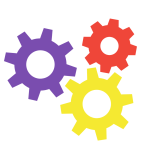
Structured Literacy → Achieving Mastery
Structured Literacy pulls together every piece of language—sounds, patterns, word parts, grammar, and meaning. By layering these skills step by step, students gain mastery of how reading and writing work. This approach turns struggling readers into independent, confident learners.


